Nabi Hussain owes his life to a yellow plastic oil container.
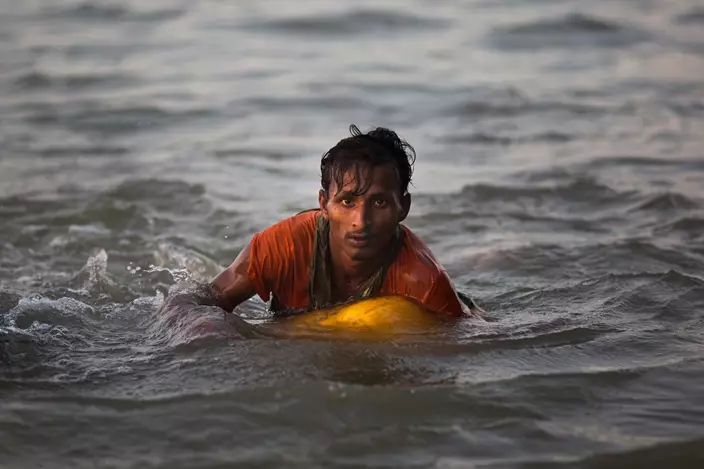
In this Nov. 4, 2017, photo, Rohingya Muslim Abdul Karim, 19, uses a yellow plastic oil container as a flotation device as he swims the Naf river while crossing the Myanmar-Bangladesh border in Shah Porir Dwip, Bangladesh. (AP Photo/Bernat Armangue)
The 13-year-old Rohingya boy couldn't swim, and had never even seen the sea before fleeing his village in Myanmar. But he clung to the empty container and struggled across the water with it for about 2 1/2 miles, all the way to Bangladesh.
Click to Gallery
Nabi Hussain owes his life to a yellow plastic oil container.
The 13-year-old Rohingya boy couldn't swim, and had never even seen the sea before fleeing his village in Myanmar. But he clung to the empty container and struggled across the water with it for about 2 1/2 miles, all the way to Bangladesh.
In this Nov. 4, 2017, photo, Rohingya Muslims use yellow plastic drums as flotation devices as they arrive at Shah Porir Dwip, Bangladesh, after swimming the Naf river. (AP Photo/Bernat Armangue)
Rohingya Muslims escaping the violence in their homeland of Myanmar are now so desperate that some are trying to swim to safety in neighboring Bangladesh. In just a week, more than three dozen boys and young men used cooking oil containers like life rafts to swim across the mouth of the Naf River and wash up ashore in Shah Porir Dwip, a fishing town and cattle trade spot.
In this Nov. 4, 2017, photo, newly arrived Rohingya Muslims sit with yellow plastic drums they used as a flotation aid while crossing the Naf river, as they wait in Shah Porir Dwip to be transferred on a refugee camp in Cox's Bazar, Bangladesh. (AP Photo/Bernat Armangue)
Although Rohingya Muslims have lived in Myanmar for decades, the country's Buddhist majority still sees them as invaders from Bangladesh. The government denies them basic rights, and the United Nations has called them the most persecuted minority in the world. Just since August, after their homes were torched by Buddhist mobs and soldiers, more than 600,000 Rohingya have risked the trip to Bangladesh.
In this Nov. 4, 2017, photo, Rohingya Muslims carrying yellow plastic drums they used as flotation devices walk down the Shah Porir Dwip dock after reaching Bangladesh. (AP Photo/Bernat Armangue)
Nabi knows almost no one in this new country, and his parents back in Myanmar don't know that he is alive. He doesn't smile and rarely maintains eye contact.
In this Nov. 4, 2017, photo, a Myanmar cattle trader watches Rohingya Muslims swimming with the help of plastic drums across the Naf river and into Bangladesh at Shah Porir Dwip dock. (AP Photo/Bernat Armangue)
Nabi's family fled, heading toward the coast, passing dead bodies. But when they arrived at the coast with a flood of other Rohingya refugees, they had no money for a boat and a smuggler.
Eventually, though, they agreed, on the condition that he not go alone. So on the afternoon of Nov. 3, Nabi joined a group of 23 other young men, and his family came to see him off.
Nabi is now alone, one of an estimated 40,000 unaccompanied Rohingya Muslim children living in Bangladesh. He looks down as he speaks, just a few feet from the water, and murmurs his biggest wish:
Late afternoon on the next day, authorities spotted a few dots in the middle of the water. It was another group of Rohingya swimming to Bangladesh with yellow plastic containers. They arrived at the same time as a pack of cattle — except that the cows came by boat.
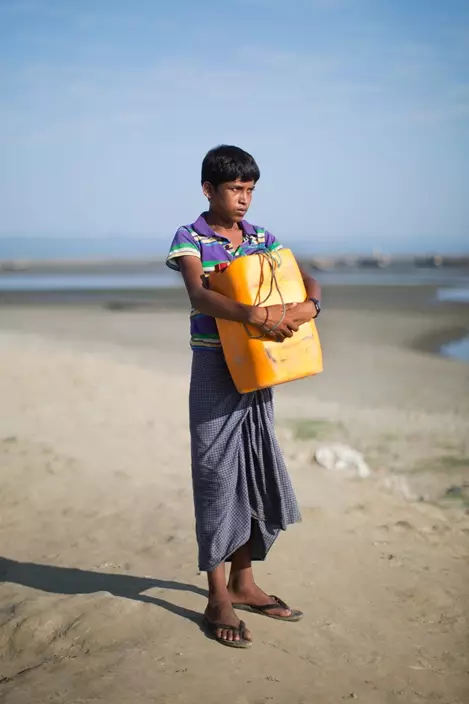
In this Nov. 4, 2017, photo, Rohingya Muslim Nabi Hussain, 13, poses for a portrait with the yellow plastic drum he used as a flotation device while crossing the Naf river in Shar Porir Dwip, south Cox's Bazar, Bangladesh. (AP Photo/Bernat Armangue)

In this Nov. 4, 2017, photo, Rohingya Muslims use yellow plastic drums as flotation devices as they arrive at Shah Porir Dwip, Bangladesh, after swimming the Naf river. (AP Photo/Bernat Armangue)
Rohingya Muslims escaping the violence in their homeland of Myanmar are now so desperate that some are trying to swim to safety in neighboring Bangladesh. In just a week, more than three dozen boys and young men used cooking oil containers like life rafts to swim across the mouth of the Naf River and wash up ashore in Shah Porir Dwip, a fishing town and cattle trade spot.
"I was so scared of dying," said Nabi, a lanky boy in a striped polo shirt and checkered dhoti. "I thought it was going to be my last day."
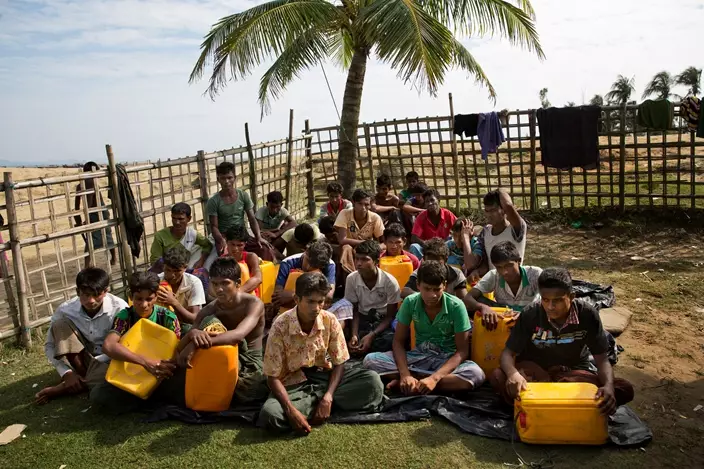
In this Nov. 4, 2017, photo, newly arrived Rohingya Muslims with yellow plastic drums they used to aid flotation while crossing the Naf river wait in Shah Porir Dwip to be transferred to a refugee camp in Cox's Bazar, Bangladesh. (AP Photo/Bernat Armangue)
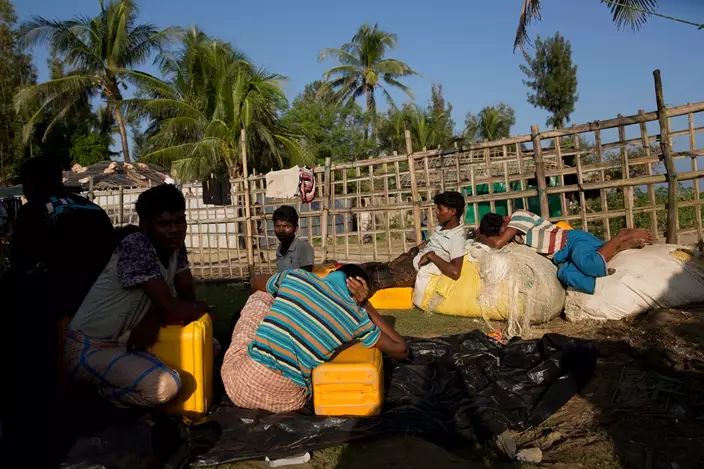
In this Nov. 4, 2017, photo, newly arrived Rohingya Muslims sit with yellow plastic drums they used as a flotation aid while crossing the Naf river, as they wait in Shah Porir Dwip to be transferred on a refugee camp in Cox's Bazar, Bangladesh. (AP Photo/Bernat Armangue)
Although Rohingya Muslims have lived in Myanmar for decades, the country's Buddhist majority still sees them as invaders from Bangladesh. The government denies them basic rights, and the United Nations has called them the most persecuted minority in the world. Just since August, after their homes were torched by Buddhist mobs and soldiers, more than 600,000 Rohingya have risked the trip to Bangladesh.
"We had a lot of suffering, so we thought drowning in the water was a better option," said Kamal Hussain, 18, who also swam to Bangladesh with an oil container.
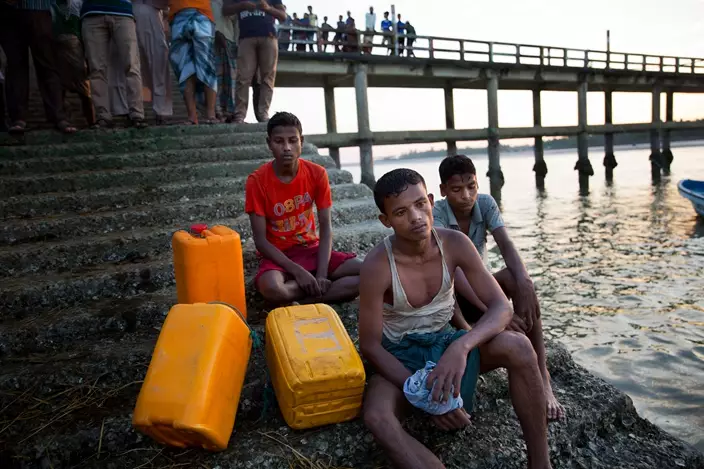
In this Nov. 4, 2017, photo, from left to right: Rohingya Muslims Belal Hussain, 15; Kamal Hussain, 18; and Robiul Hassan, 15; rest after swimming the Naf river in Shah Porir Dwip, Bangladesh. (AP Photo/Bernat Armangue)
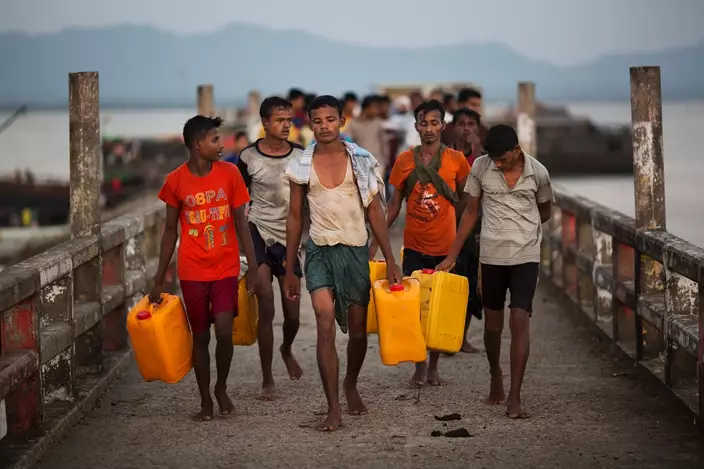
In this Nov. 4, 2017, photo, Rohingya Muslims carrying yellow plastic drums they used as flotation devices walk down the Shah Porir Dwip dock after reaching Bangladesh. (AP Photo/Bernat Armangue)
Nabi knows almost no one in this new country, and his parents back in Myanmar don't know that he is alive. He doesn't smile and rarely maintains eye contact.
Nabi grew up in the mountains of Myanmar, the fourth of nine children of a farmer who grows paan, the betel leaf used as chewing tobacco. He never went to school.
The trouble started two months ago when Rohingya insurgents attacked Myanmar security forces. The Myanmar military responded with a brutal crackdown, killing men, raping women and burning homes and property. The last Nabi saw of his village, all the homes were on fire.

In this Nov. 4, 2017, photo, Myanmar cattle traders unload cows at Shah Porir Dwip dock, Bangladesh. (AP Photo/Bernat Armangue)

In this Nov. 4, 2017, photo, a Myanmar cattle trader watches Rohingya Muslims swimming with the help of plastic drums across the Naf river and into Bangladesh at Shah Porir Dwip dock. (AP Photo/Bernat Armangue)
Nabi's family fled, heading toward the coast, passing dead bodies. But when they arrived at the coast with a flood of other Rohingya refugees, they had no money for a boat and a smuggler.
Every day, there was less food. So after four days, Nabi told his parents he wanted to swim the delta to reach the thin line of land he could see in the distance — Shah Porir Dwip.
His parents didn't want him to go. One of his older brothers had left for Bangladesh two months ago, and they had no idea what had happened to him. They knew the strong currents could carry Nabi into the ocean.
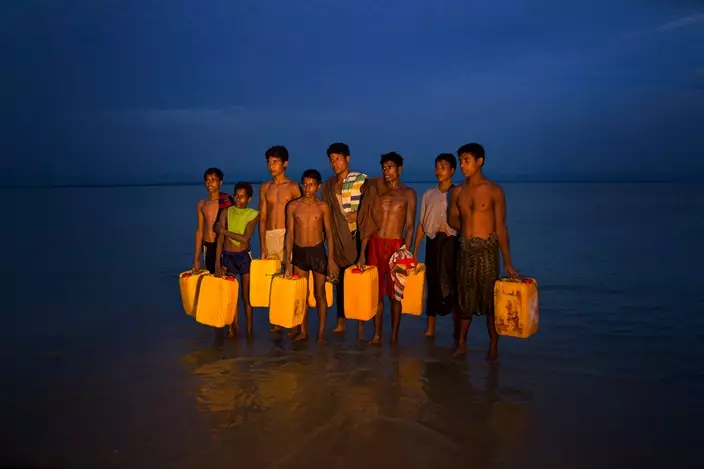
In this Nov. 5, 2017, photo, newly arrived Rohingya Muslims carry yellow plastic drums they used as flotation aids and listen to Bangladeshi authorities, not pictured, after swimming across the Naf river at Shah Porir Dwip, Bangladesh. (AP Photo/Bernat Armangue)
Eventually, though, they agreed, on the condition that he not go alone. So on the afternoon of Nov. 3, Nabi joined a group of 23 other young men, and his family came to see him off.
"Please keep me in your prayers," he told his mother, while everyone around him wept.
Nabi and the others strapped the cooking oil containers to their chests as floats, and stepped into the water just as the current started to shift toward Bangladesh. The men stayed in groups of three, tied together with ropes. Nabi was in the middle, because he was young and didn't know how to swim.
Nabi remembers swallowing water, in part because of the waves and in part to quench his thirst. The water was salty. His legs ached. But he never looked behind him.
Just after sundown, the group reached Shah Porir Dwip, exhausted, hungry and dehydrated.
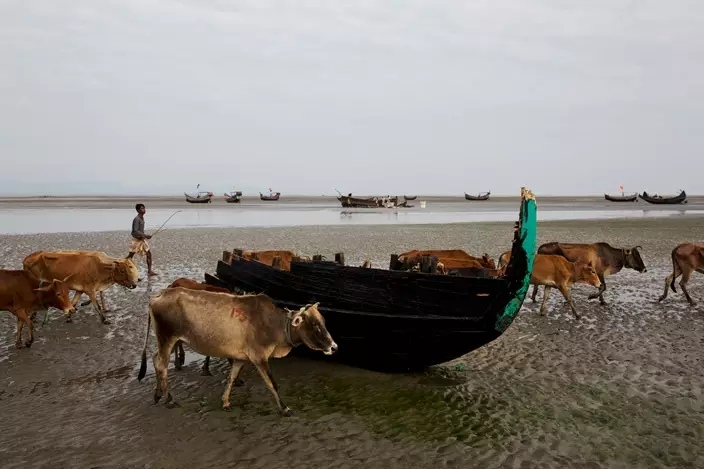
In this Nov. 5, 2017, photo, cows walk past a broken wooden boat, previously used by Rohingya Muslims, at Shah Porir Dwip, Bangladesh. (AP Photo/Bernat Armangue)
Nabi is now alone, one of an estimated 40,000 unaccompanied Rohingya Muslim children living in Bangladesh. He looks down as he speaks, just a few feet from the water, and murmurs his biggest wish:
"I want my parents and peace."
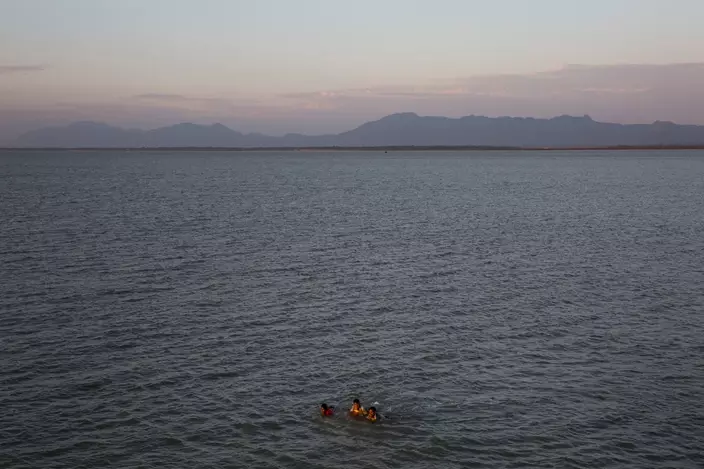
In this Nov. 4, 2017, photo, three Rohingya Muslims swim the Naf river while crossing the Myanmar-Bangladesh border in Shah Porir Dwip, Bangladesh. (AP Photo/Bernat Armangue)
Late afternoon on the next day, authorities spotted a few dots in the middle of the water. It was another group of Rohingya swimming to Bangladesh with yellow plastic containers. They arrived at the same time as a pack of cattle — except that the cows came by boat.
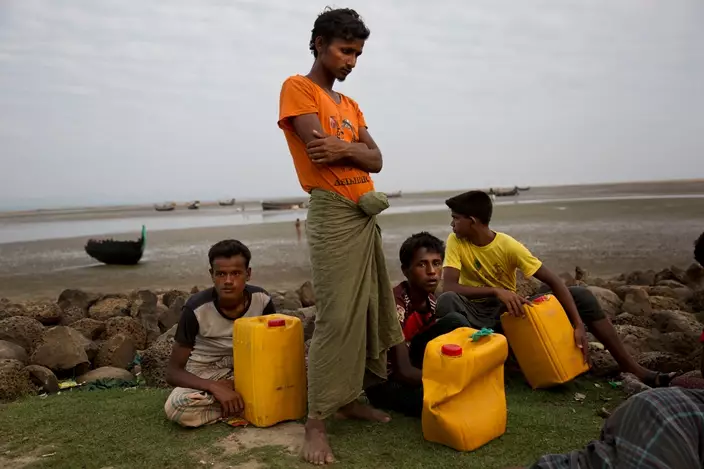
In this Nov. 5, 2017, photo, newly arrived Rohingya Muslim Aman Ullah, 18, left, Abdul Karim, 19, second left, Mohammed Sadek, 14, third left and Robiul Hassan, 15, right, wait in Shah Porir Dwip, Bangladesh to be transferred to a refugee camp in Cox's Bazar, Bangladesh.(AP Photo/Bernat Armangue)
BANGKOK (AP) — Myanmar’s military has begun basic training at military bases and schools across the country for draftees called up under the country’s recently activated conscription law, state-run media reported on Tuesday.
The authorities activated the conscription law in February in a bid to to replenish the ranks that have been depleted in nationwide battles against ethnic minority armed groups and armed pro-democracy resistance forces opposed to military rule. The struggle began when the army seized power from the elected government of Aung San Suu Kyi in February 2021.
Over the past five months, the army has lost territory in northern Shan state and in Rakhine state in the west, and is under growing attack elsewhere. It appeared this week that it may also lose the important trading town of Myawaddy, in Kayin state on the border with Thailand.
Opening ceremonies for training were held in various regional commands and military schools in Mon and Shan states and Tanintharyi, Magway and Mandalay regions, as well as in the capital, Naypyitaw, the state-run Myanma Alinn newspaper reported Tuesday.
It said the first batch of trainees were those who voluntarily reported to the army after the military government sent letters summoning them.
The conscription law’s activation has created fear, anxiety and defiance among young people and their parents. Some are leaving the country, while others are fleeing into border areas controlled by ethnic minorities or joining resistance groups.
Independent Myanmar media reported Tuesday that a few young people staged brief protests against conscription at three locations in Yangon, the country’s largest city. The protests on Monday were carried out as flash mobs to evade attacks or arrests by the authorities.
Under the law, men aged 18 to 35 and women 18 to 27 can be drafted into the armed forces for two years. The military has said about 14 million men and women of the total 56 million population of the country are eligible for military service and it will draft 5,000 people at a time and up to 60,000 people a year. Evading conscription is punishable by three to five years in prison and a fine.
Myanmar’s military is also reportedly tapping an unlikely source to fill its depleted ranks, turning to members of the the Muslim Rohingya minority, who seven years ago were the targets of a brutal counterinsurgency campaign incorporating rape and murder that saw an estimated 740,000 flee to neighboring Bangladesh as their villages were burned down.
Analysts say the move is meant not only to counter the army’s attrition though deaths, desertions and defections, but also constitutes a divide and conquers strategy meant to reignite tensions between ethnic groups in Rakhine.
Rohingya have lived especially in Rakhine for generations, but they are not officially recognized as an indigenous ethnic minority, instead being called Bengalis and described as illegal immigrants. They have been denied citizenship and other basic rights including freedom of movement, and are the targets of widespread social discrimination. The U.N. has estimated that 600,000 Rohingya are still living in Myanmar.
The main anti-military resistance force in Rakhine state is the Arakan Army, which is part of the movement seeking greater autonomy for the Rakhine ethnic group that dominates the area. Rakhine nationalists were among the leading persecutors of the Rohingya minority, but now the Arakan Army and the Rohingya have a common enemy in the military government to took power in 2021, making them uneasy allies.
Aung Kyaw Moe, a Rohingya who is deputy minister for human rights in the shadow National Unity Government, said last month that the military is creating a conflict between the Rohingya and Rakhine ethnic groups in hopes of regaining the military advantage in Rakhine.
“The military council is losing the battles nationwide. Especially in Rakhine, military camps are being abandoned almost every day, and the towns controlled by the military council are falling. In Rakhine, the military council is in need of a lot of human resources due to the depletion of the army. It seems that they have calculated that only by creating a conflict between Rakhine and Rohingya can the current situation be changed,” Aung Kyaw Moe said.
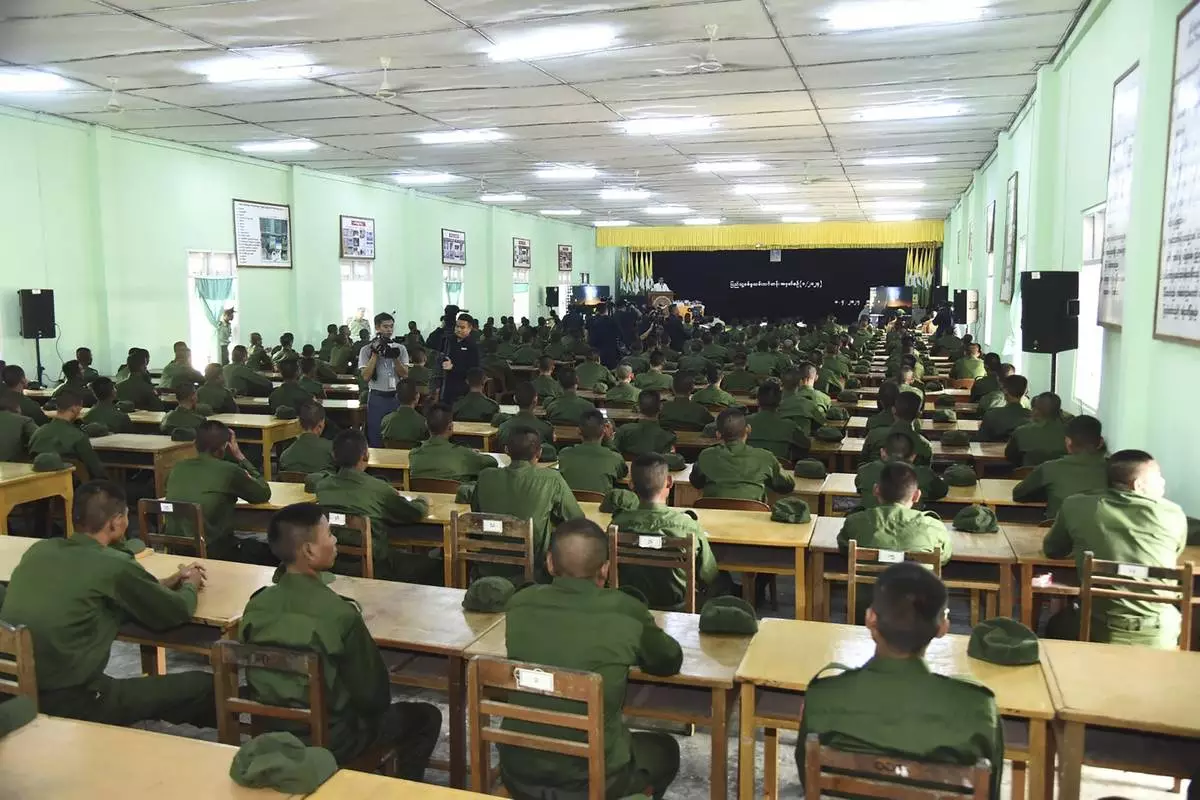
In this undated photo released on April 8, 2024 by The Military True News Information Team, trainees of first batch of military service attend an opening ceremony for their training session at a military compound in Mandalay, Myanmar. Myanmar’s military has begun basic training at military bases and schools across the country for draftees called up under the country’s recently activated conscription law, state-run media reported on Tuesday, April 9.(The Military True News Information Team via AP)
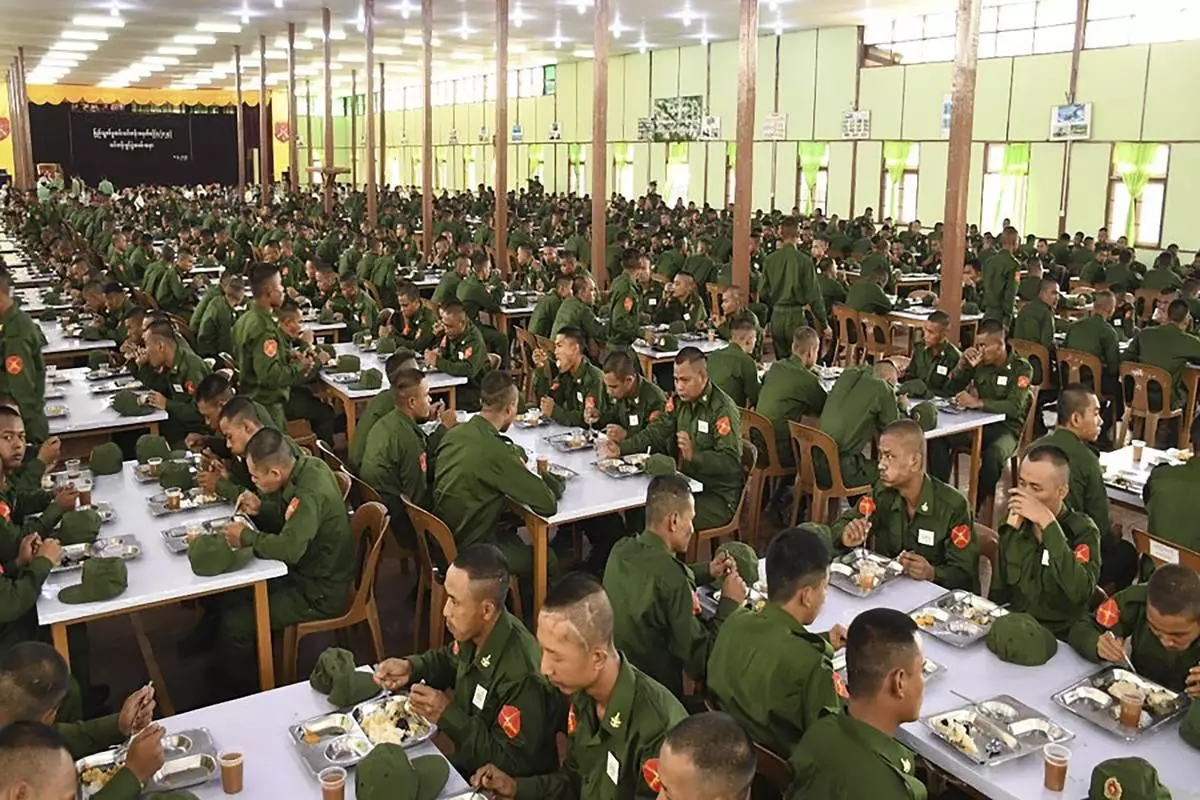
In this undated photo released on April 8, 2024, by The Military True News Information Team, trainees of first batch of military service have meals as an opening ceremony for their training session was held at a military compound in Yangon, Myanmar. Myanmar’s military has begun basic training at military bases and schools across the country for draftees called up under the country’s recently activated conscription law, state-run media reported on Tuesday, April 9.(The Military True News Information Team via AP)
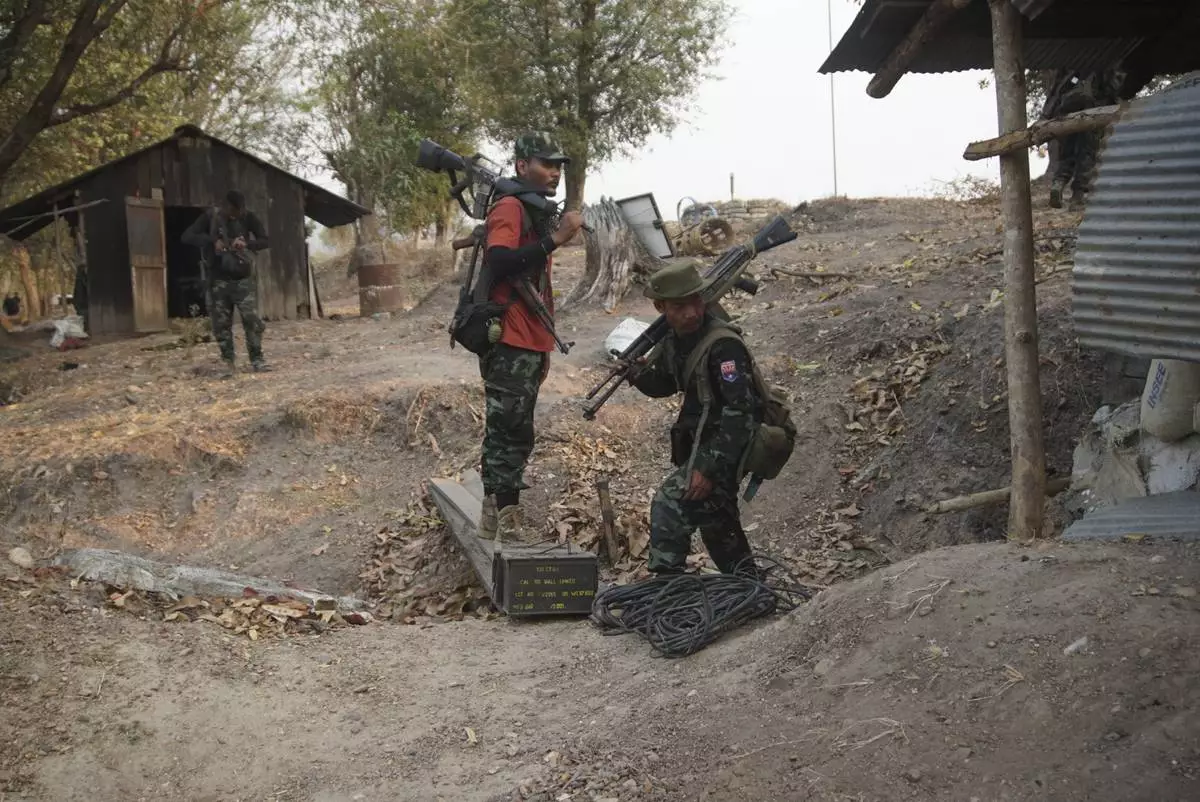
Members of the Karen National Liberation Army and People’s Defense Force collect weapons after they captured an army outpost, in the southern part of Myawaddy township in Kayin state, Myanmar, March 11, 2024. (AP Photo/METRO)
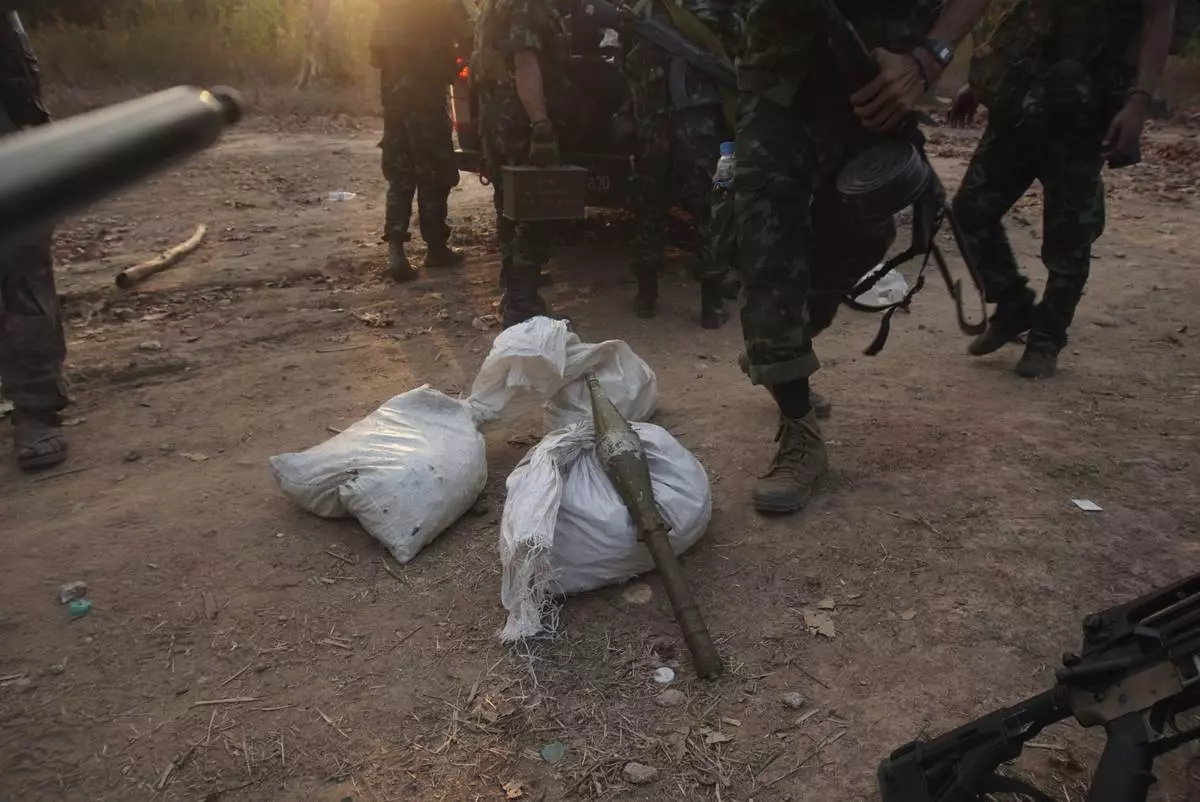
Members of the Karen National Liberation Army and People’s Defense Force collect weapons after they captured an army outpost, in the southern part of Myawaddy township in Kayin state, Myanmar, March 11, 2024. (AP Photo/METRO)
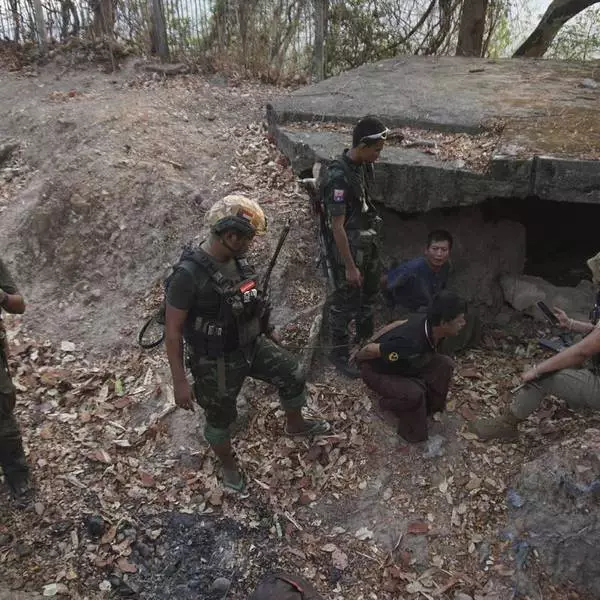
Myanmar military begins basic training for draftees as resistance forces keep the pressure on
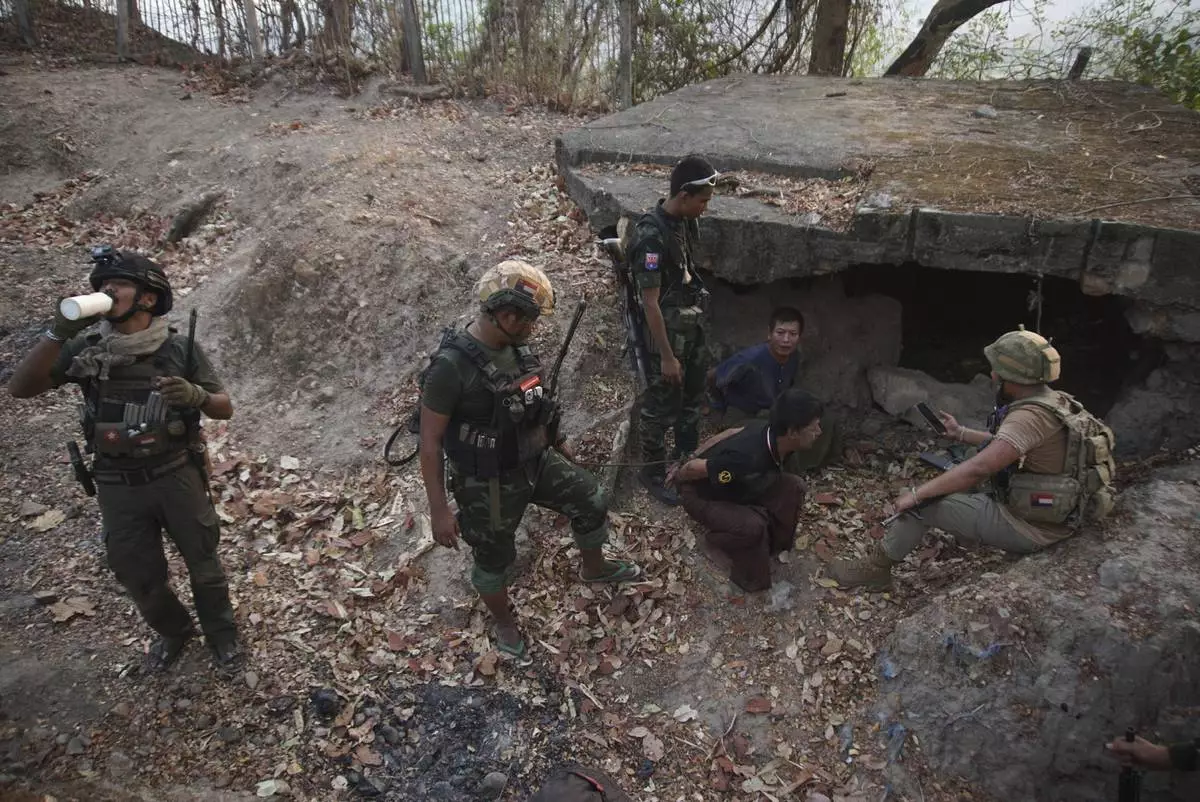
Members of the Karen National Liberation Army and People’s Defense Force examine two arrested soldiers after they captured an army outpost, in the southern part of Myawaddy township in Kayin state, Myanmar, March 11, 2024. (AP Photo/METRO)
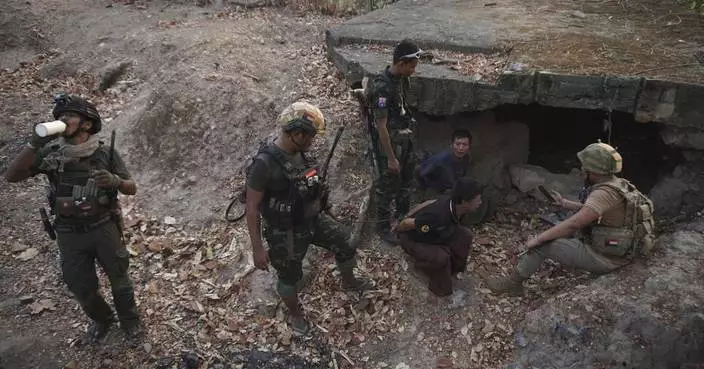
Myanmar military begins basic training for draftees as resistance forces keep the pressure on






















